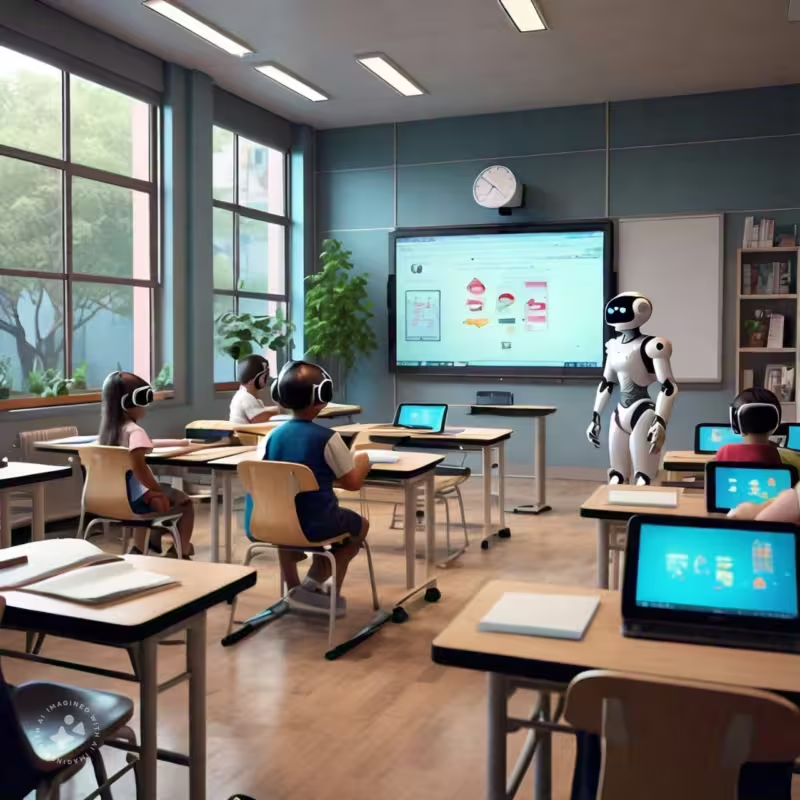The traditional approach to education has long been a one-size-fits-all model, where teachers strive to meet the needs of a diverse group of students with a single, standardized teaching method. However, this approach often results in some students being left behind, while others are not adequately challenged. In contrast, personalized learning seeks to tailor the educational experience to each individual student’s needs, abilities, and learning style. This approach has been shown to lead to improved academic outcomes, increased student engagement, and better teacher-student relationships (Dziuban, Moskal, & Williams, 2018). The integration of Artificial Intelligence (AI) in education is poised to revolutionize personalized learning, enabling teachers to create customized learning plans, automate grading, and identify knowledge gaps like never before. With AI, the future of education looks brighter than ever, promising to unlock each student’s full potential.
How AI Personalizes Learning
Identifying Student Needs
AI algorithms analyze various student data points, such as test scores, learning pace, and assessment results, to identify areas of strength and weakness. This analysis enables teachers to create targeted interventions and personalized learning plans. Adaptive learning platforms, like DreamBox and Curriculum Associates, utilize AI to adjust the difficulty level of course materials based on a student’s performance, providing a tailored learning experience (Wylie, 2020).
Tailoring Instruction and Content
AI-powered systems recommend learning materials and activities suited to individual students’ needs, abilities, and learning preferences. For instance, AI-driven content curation tools like Netex Learning’s Adaptive Learning Platform suggest relevant educational resources, while AI-powered tutoring systems like Carnegie Learning’s Cognitive Tutor provide targeted feedback and support (Raca, 2019).
Engaging Students in Different Ways
AI can personalize learning styles by offering content in various formats, such as audio, video, or text, to cater to different learning preferences. AI tools like Knewton’s Adaptive Learning Platform create interactive learning experiences that adjust to individual students’ learning styles, whether visual, auditory, or kinesthetic (Knewton, 2020). By acknowledging and accommodating these differences, AI-powered education increases student engagement and motivation.
(Wylie, E. C. (2020). Adaptive learning in elementary mathematics: A randomized controlled trial. Journal of Educational Data Mining, 12(1), 1-43.)
(Raca, M. (2019). AI-powered adaptive learning: A review of the literature. Journal of Educational Technology Development and Exchange, 12(1), 1-22.)
(Knewton. (2020). Adaptive learning platform. Retrieved from https://www.knewton.com/adaptive-learning-platform/)
The Benefits of AI-Personalized Learning
Increased Student Engagement and Motivation
Personalized learning, powered by AI, fosters a sense of ownership and control over learning, as students are able to learn at their own pace and explore topics that interest them. AI-powered tools, such as interactive simulations and gamified learning platforms, make learning more engaging and enjoyable, increasing student motivation and participation (Gauthier, 2019). By providing a tailored learning experience, AI helps students take an active role in their education, leading to increased autonomy, self-efficacy, and overall engagement.
Improved Learning Outcomes
Personalized learning allows students to learn at their own pace, master concepts more effectively, and retain information longer. Studies have shown that AI-personalized learning leads to improved learning outcomes, including increased academic achievement and standardized test scores (Dziuban, Moskal, & Williams, 2018). For example, a study by RAND Education found that personalized learning led to significant gains in math and reading scores for students in grades K-12 (Pane, 2017). AI-powered adaptive learning systems have also been shown to lead to better learning outcomes, as they adjust the difficulty level of course materials based on individual student performance.
Equity and Addressing Learning Gaps
AI-powered personalized learning helps identify students who need extra support early on, allowing educators to provide targeted interventions and address learning gaps more effectively. By catering to diverse learning needs, personalized learning bridges achievement gaps and promotes equity in education. AI-powered tools can also help identify and address systemic biases in education, leading to a more inclusive and equitable learning environment (Lopez, 2020). By providing a tailored learning experience, AI helps ensure that every student has the opportunity to succeed, regardless of their background or learning style.
The Role of Teachers in the AI-Powered Classroom
The integration of AI in education is not intended to replace teachers, but rather to support and augment their role. AI is designed to handle administrative tasks, such as grading and data analysis, freeing up teachers’ time for more personalized interactions with students. With AI, teachers can focus on what they do best: providing emotional support, guidance, and human connection.
AI can help teachers tailor their teaching strategies and provide more effective support by:
- Analyzing student data to identify areas of strength and weakness
- Providing real-time feedback and insights on student progress
- Suggesting targeted interventions and personalized learning plans
- Enabling teachers to create customized learning experiences
By leveraging AI insights, teachers can optimize their teaching methods, better address individual student needs, and create a more dynamic and effective learning environment. Ultimately, the role of teachers in the AI-powered classroom is to provide the human touch, creativity, and empathy that AI systems cannot replicate.
As noted by the National Education Association (NEA), “AI should be seen as a tool to enhance teaching and learning, not replace teachers” (NEA, 2020). By embracing AI as a supportive tool, teachers can focus on what matters most: empowering students to succeed.
(NEA (2020). AI in Education: A Guide for Teachers. National Education Association.)
The Future of AI in Education (Looking Forward)
As AI technology continues to evolve, we can expect to see emerging trends in education, such as:
- AI-powered virtual reality learning experiences: Immersive learning environments that simulate real-world situations, making learning more engaging and interactive.
- Natural Language Processing (NLP): Enhancing language learning and literacy skills through AI-driven chatbots and virtual assistants.
- Predictive analytics: Identifying at-risk students and providing targeted interventions to ensure academic success.
However, it’s crucial to acknowledge potential challenges, such as:
- AI bias: Ensuring that AI systems are fair, transparent, and free from biases that could perpetuate educational inequities.
- Responsible development: Prioritizing human oversight, data privacy, and ethical considerations in AI development.
Despite these challenges, the future of AI in education holds immense promise. By harnessing the power of AI, we can:
- Transform education: Creating personalized, adaptive, and inclusive learning experiences that cater to diverse student needs.
- Empower future generations: Preparing students for success in an increasingly complex and rapidly changing world.
With responsible development and deployment, AI has the potential to revolutionize education, making high-quality learning experiences accessible to all. As we look forward, it’s clear that AI will play a vital role in shaping the future of education, and we must embrace this transformation to create a brighter future for all learners.
Conclusion
In conclusion, AI has the potential to revolutionize education by providing personalized learning experiences that cater to individual students’ needs, abilities, and learning styles. Key points include:
- AI can analyze student data to identify strengths and weaknesses, tailoring instruction and content to meet unique needs.
- AI-powered tools can engage students in different ways, increasing motivation and participation.
- AI can help teachers identify learning gaps, provide targeted support, and improve learning outcomes.
- AI is a tool to support teachers, not replace them, freeing up time for more personalized interactions.
We encourage educators to explore AI tools and consider their potential benefits for their classrooms. By embracing AI-powered personalized learning, we can create a more inclusive, effective, and student-centered education system. Join the journey to transform education and unlock each student’s full potential.
Final Thoughts
The future of education is here, and AI is leading the way. Let’s harness the power of AI to create a brighter future for all learners.






